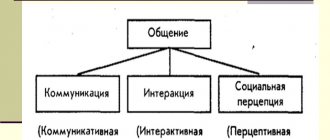There are situations when a person feels insecure in communicating with others, or he lacks the knowledge and skills of how to convey his will to his interlocutor. In such cases, effective methods of psychological influence on the interlocutor help. This article describes in detail how to influence people using psychology and what not to do.
Psychological influence helps to assert oneself in society
Techniques of influence: features, hidden capabilities, precautions
Psychological influence has one goal - to force a person or group of people to comply with a requirement or change their mind. Many people use means of influence in everyday life unconsciously, focusing on their needs. Therefore, the influence can be positive, useful for a person, or negative - destructive.
Parents instill in their children the rules of behavior in society, trying to raise them to be law-abiding people. The director influences his subordinates in order to obtain a cohesive team ready to work on a common task. Advertising creators use techniques similar to hypnosis to encourage customers to buy a product that they did not initially need. Interpersonal influence, unlike group influence, is rarely destructive. It is not authoritarian in nature, it is easier to get rid of it.
A striking example of the dangerous influence of group psychological influence is the recruitment of people into the ranks of terrorist organizations. To instill in a person thoughts of the need to commit mass murder, it is necessary to completely change his personality. People are reduced to the state of zombies who are no longer able to think critically.
Every person who uses suggestion techniques in everyday life must understand the degree of responsibility. If psychological influence is used unsuccessfully or too often, it is possible to put a person into a state of artificial depression and suppress his will. It is easiest to convince a person with low self-esteem and who does not have an opinion of something. Those at risk include children, the elderly, and people with undeveloped critical thinking.
What does NLP consist of?
NLP methods of influence belong to the section of neurolinguistic programming. Through it, the individual’s connection with his subconscious is established. There are rich hidden resources within a person. Not every person knows how to use them.
Thanks to access to invisible resources, information is extracted from the subconscious. It is delivered to the conscious part of the human psyche. The best NLP techniques can work in both positive and negative ways. Stereotypes about the perception of the outside world are planted in the unconscious sphere. For example, an individual forms an opinion about the structure of the world, ways of obtaining information, and correct behavior. So the psyche can be influenced both to benefit the individual and cause damage to it. This is the external nervous activity of the human body.
The basis for the assimilation of information by the psyche is divided into the following systems:
- data perception stage;
- processing of information;
- systematization and storage.
NLP methods of influencing people have certain principles. They can help improve human performance.
It is customary to highlight the following factors:
- With consistency or report, existence occurs with oneself and the surrounding world. It is enough to recognize the fact that certain phenomena exist in the world.
- With clear ideas, results emerge. It may concern a specific situation or process. It is important to have clarity in consciousness, an unambiguous understanding.
- Mindfulness helps you achieve results. Feelings should be open, this speeds up movement towards the intended goal.
- With flexibility in approaches, you can skillfully achieve your goals.
Thus, NLP methods of influencing a person are capable of changing his consciousness. This requires certain external and internal settings.
How does psychological influence work?
To achieve the desired result, you need to influence a person constantly and persistently. The best example of such an influence on consciousness is advertising. In the 20th century, its means were posters and signs, which were easy to ignore. But with the development of television and other media, advertising has become a separate art form.
Commercials not only demonstrate the qualities of a product, they shape people’s worldview and attitude towards a certain situation. Through a short video you can shape public opinion, cause joy, anger, and mistrust. These types of advertising include political and social. They influence the subconscious, appealing to emotions. Repeated repetition of commercials makes viewers doubt their own opinions and act as the advertisement suggests. Manipulation of public opinion allows you to gain the support of people in a non-violent way, simply by presenting information in such a way that they see benefit in it for themselves.
Basics
People who live together constantly have a certain influence on each other. At the same time, they pursue their own personal motives.
Psychological influence – mechanisms that can simulate the thinking of an individual.
The impact has main factors:
- character study;
- understanding ways to respond to stress;
- behavioral characteristics.
A manipulator is able to carry out conscious actions, and a person can also manipulate without realizing that he is affecting someone’s psyche. Do not forget that employees of various services are interested in people making the decision that is right for them. Sellers say the right words to the buyer so that he purchases the product. Do not forget about the actions used by scammers who are capable of stealing by fooling around.
Types of ways to influence the perception of the interlocutor
A person can be influenced by choosing one of the main strategies: aggressive or passive. An aggressive strategy requires the manipulator to be able to confidently and easily build logical chains and consciously replace facts with fiction. While conducting a discussion, an aggressive manipulator forces his opponent to constantly object, lose the flow of the conversation, and, ultimately, agree with the arguments presented. But this effect can only be achieved if the interlocutor has a desire to engage in a lengthy discussion. To do this, you need to provoke him, captivate him with the subject of conversation, and create a desire to argue. An unconvincing and insufficiently persistent manipulator simply will not be able to generate the required level of interest.
The passive form is suitable for closer communication with a person whom the manipulator knows well. The structure of the conversation should be trusting, persistent, but not active. You need to slowly lead your interlocutor to the desired conclusions, choosing analogies that are understandable to him, giving suitable examples from life. It is important to ensure that the arguments do not contradict each other, but work towards the same idea. The more the interlocutor trusts the manipulator, the faster he will agree with the arguments presented.
Basic rules of psychological influence
The best way to develop manipulative skills is constant practice. It is also important to follow the basic rules that make psychological influence effective:
- confident tone;
- gradual impact;
- consolidation of intermediate results;
- alternation of management methods;
- strengthening the authority of the manipulator;
- focusing on the needs of the interlocutor;
- use of illustrative examples.
It is also important to consider the characteristics of the person or group being influenced. So, for a girl you should choose some methods, for a guy - others.
Belief
This method has three components: thesis, arguments and demonstration. First, you formulate a specific position - this is a thesis, then you form arguments, and at the end, with the help of a demonstration, you convince the target audience.
The method is very effective if you know the secrets of persuasion:
terms and arguments should be extremely simple and understandable; use only those facts that you are sure are true; take into account the personality characteristics of the interlocutor; carry on a conversation without discussing other people; your speech should be simple, without complex epithets and popular expressions.
Much of your success depends on the arguments you make. Effective are those arguments that are supported by well-known facts, relate specifically to the topic of conversation, are interesting to the interlocutor and have not lost their relevance.
What methods of influence are used in psychology?
In a situation where it is necessary to influence, replacing the very essence of views, one should use methods of psychological influence on a person’s consciousness:
- Psychological pressure. An intense form of influence that works on the basis of submission to authority. You should speak not just in a convincing tone, but choose an intonation that does not allow for objections. She must subjugate the will of the listeners and force them to perform the required actions. This method is used by leaders; it is typical for the army and police institutions.
- Psychological attack. It is a series of techniques. A rapid change in methods of influence includes changes in tone, body position, and tempo of speech.
- Manipulation. To achieve an effect, the manipulator must evoke dual images in the listener that will make him doubt his own opinion. Under pressure from the manipulator, he changes his mind, accepting the imposed ideology, perceiving it as truthful, even if it is not.
- Programming. The constant repetition of the same expressions during a conversation pushes the interlocutor to accept the position of the manipulator as his own.
A conversation between a manipulator and suggestible people is similar to a cat playing with a caught mouse. The main task of the cat is to allow the prey to think that it can escape at any moment, but not to allow it to run away too far.
Available methods of mind manipulation for beginners
To use psychological techniques to influence a person, it is not necessary to become a professional psychologist. In everyday communication, anyone can use the following methods:
- Suggestion. An authoritative person can use this method. By choosing the right phrases and constructing his speech, he inspires people with the necessary information. This method will only work if the manipulator is able to speak confidently. Slurred speech is subconsciously rejected by the listener and perceived as unreliable.
- Infection. A way of transmitting emotional mood to other people based on a chain reaction. In a dangerous situation, a person prone to panic infects other people with it. A provocateur in a crowd specifically increases the aggressiveness of people, increasing the overall level of aggression. Positive emotions can also be transmitted: if someone in a group starts laughing, his laughter will be picked up by others.
- Imitation. An effective method if the targets are children or poorly educated people. The need for a role model pushes them to copy the behavior and way of thinking of an authority figure.
- Belief. This technique is suitable for persuading a person with a high level of education. The manipulator must withstand a high level of discussion, present truthful arguments, allowing the interlocutor to come to the necessary conclusions himself.
Manipulative influence is possible only if the level of intelligence of the manipulator is higher than that of the interlocutors. Otherwise, a smarter interlocutor can intercept the conversation and control the manipulator itself.
How to control your interlocutor during a conversation
During a conversation, you should alternate psychological techniques so as not to arouse suspicion among people. To cause location, you need:
- address the interlocutor by name;
- smile slightly, but make sure that it does not look like a mockery;
- when meeting, say hello first, looking into the eyes of your interlocutor;
- start communication with an unobtrusive compliment;
- repeat facial expressions and gestures of partners.
During communication, it is important to monitor the reactions of your interlocutors. You cannot turn a conversation into an interrogation or an endless monologue, from which people will quickly get tired. To understand how a person relates to the manipulator and other interlocutors, you need to pay attention to his posture. If he sits freely, with his body turned towards his interlocutors, without crossing his legs, he feels comfortable and will be easily influenced. If the toes of the shoes are pointed inward or to the side, the person wants to end the conversation. He needs to be helped to feel free, to be allowed to speak out.
During an argument, you should not raise your voice. The louder a person speaks, the less people listen to him. The interlocutor will try not to convince, but to shout down the other. You need to allow him to speak loudly and emotionally, without trying to stop or respond to accusations. When a person speaks out, he will feel devastated and guilty. In such a situation, it is easier to manage it and bring it to the necessary conclusions. When talking to a liar, you cannot put pressure on him, forcing him to confess. You need to speak slowly, pausing. The interlocutor will try to fill the pauses himself and let it slip against his will.
To obtain consent, a proposal must begin with an affirmation. Speak insinuatingly, but do not fuss. You cannot start a sentence with an apology - this immediately puts the person in the position of a subordinate. When using arguments, you should start with the strongest, supplementing it with average degrees of conviction. You also need to end with a compelling argument. You can force your interlocutor to agree unwittingly using the “three yeses” technique. You need to ask two questions to which a person is guaranteed to answer with consent, and then ask the main one. By inertia, the interlocutor, without hesitation, agrees.
Other techniques
Open Loop and Fractal Loop Techniques
These techniques make a person susceptible to influence, manipulation, and suggestion.
Open loop technique. The purpose of this technique is to interest and arouse curiosity. Those. you create within a person an internal need to somehow either communicate with you further, or find out something about your question, or find out something about a specific product.
The essence of the technique is open cycles. The human brain has such a property that it tries to finish any thought it starts. For example, it makes you watch an uninteresting movie or finish reading a boring book (you want to know how it ends at the end).
And we can exploit this thing. We create an open loop and some kind of distraction in the interlocutor’s head (examples: “We need to talk, but not here and not now, let’s do it later,” “I know something about you, but it’s better to talk about it somewhere else in private.” ). And the interlocutor’s brain tries to close this cycle. And the interlocutor himself will initiate a continuation to close the cycle.
Depending on your goals, you can close this cycle or extend it further. You can stall for time so that the interlocutor himself asks you.
Classic examples of the use of technology:
- This is how Apple products are sold. First there are news, expectations, reviews, pre-orders, and then the product is released onto the market (iPhones, iPads).
- Trailer before the release of the new film.
- Almost any series. For example, “Breaking Bad”, “Game of Thrones”. Each episode ends with an open loop.
If you leave the loop too long, or open too many loops and don't close them, you can get the opposite effect, loss of interest or aggression.
To make the technique work even more powerfully, create open loops that will be interesting to your interlocutor.
Conclusion: these open loops force our interlocutor to initiate what we want. Those. we want him to be interested in something, we create an open cycle for him on this topic, and he himself asks us about it. This works great to create curiosity and interest.
Fractal loop technique. Very similar to the previous one, but there are differences. The essence of the technique: you open a phrase without finishing it, start the next phrase without finishing the second, start a third, and so on in a spiral.
At the same time, the interlocutor’s brain tries to maintain several open cycles at the same time. And this is where it burns out.











